Aquatic Invertebrates
Media

Species Types
Scientific Name
Freshwater species in the phylum Bryozoa
Description
Bryozoans are tiny, filter-feeding invertebrates. They create colonies that can be mossy, branching, or round and jellylike.
Media
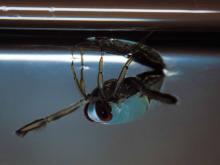
Species Types
Scientific Name
About 32 North American species in the family Notonectidae
Description
Sometimes called “water bees” or “water wasps,” backswimmers are predaceous and can deliver a painful bite if mishandled. True to their name, they swim belly-up, and their backs are keeled like a boat, which makes back-swimming easier.
Media
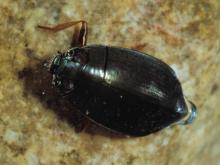
Species Types
Scientific Name
Species in the beetle family Gyrinidae
Description
Groups of whirligig beetles swim on the water surface in quick, random patterns, searching for food. They have two pairs of eyes — one pair above water, one pair below — to help them quickly and accurately capture their prey.
Media
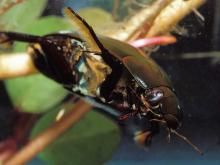
Species Types
Scientific Name
Species in the beetle family Dytiscidae
Description
Like many aquatic insects, these large oval beetles prey voraciously on other aquatic organisms. Excellent swimmers, they fly well, too, and are often attracted to lights.
Media

Species Types
Scientific Name
Beetles in the family Hydrophilidae
Description
Water scavenger beetles are a mostly aquatic family. They are similar to predaceous diving beetles, but unlike them many have a distinctive spine running down the center of their bellies.
Media
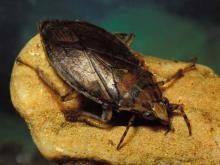
Species Types
Scientific Name
Species in the genera Abedus, Belostoma, and Lethocerus
Description
Giant water bugs are huge aquatic insects that frequently fly around electric lights at night. They are infamous for the painful bite they can deliver, but fish, birds — and some people — find them tasty!
Media
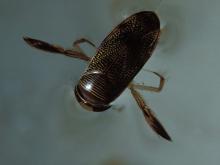
Species Types
Scientific Name
About 125 species in North America in the family Corixidae
Description
Water boatmen are one of the few aquatic true bugs that are not predatory and do not bite people. Instead, they suck juices from algae and detritus. Only a few types eat other small aquatic creatures.
Media
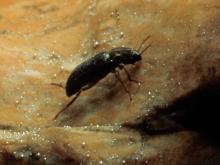
Species Types
Scientific Name
About 100 species in North America north of Mexico
Description
Riffle beetles live underwater, in shallow, swift-flowing streams, as both adults and larvae. The adults, the size of small ants, are oval with long legs. The larvae are elongated, multi-segmented, and rather hard and stiff; they reach about ½ inch long.
Media
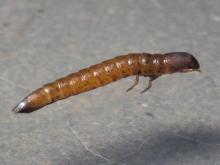
Species Types
Scientific Name
About 100 species in North America north of Mexico
Description
Riffle beetles live underwater, in shallow, swift-flowing streams, as both adults and larvae. The larvae are elongated, multi-segmented, and rather hard and stiff; they reach about ½ inch long. The adults, the size of small ants, are oval with long legs.
Media
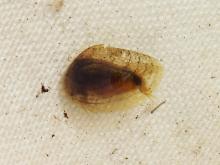
Species Types
Scientific Name
Cyclestherida, Laevicaudata, and Spinicaudata (orders or suborders)
Description
Clam shrimp have their carapace shaped like a pair of clam shells and they can close it tightly when disturbed. But they are not clams: they have tiny, jointed shrimplike legs and bristly, feathery antennae.
See Also
About Aquatic Invertebrates in Missouri
Missouri's streams, lakes, and other aquatic habitats hold thousands of kinds of invertebrates — worms, freshwater mussels, snails, crayfish, insects, and other animals without backbones. These creatures are vital links in the aquatic food chain, and their presence and numbers tell us a lot about water quality.





















